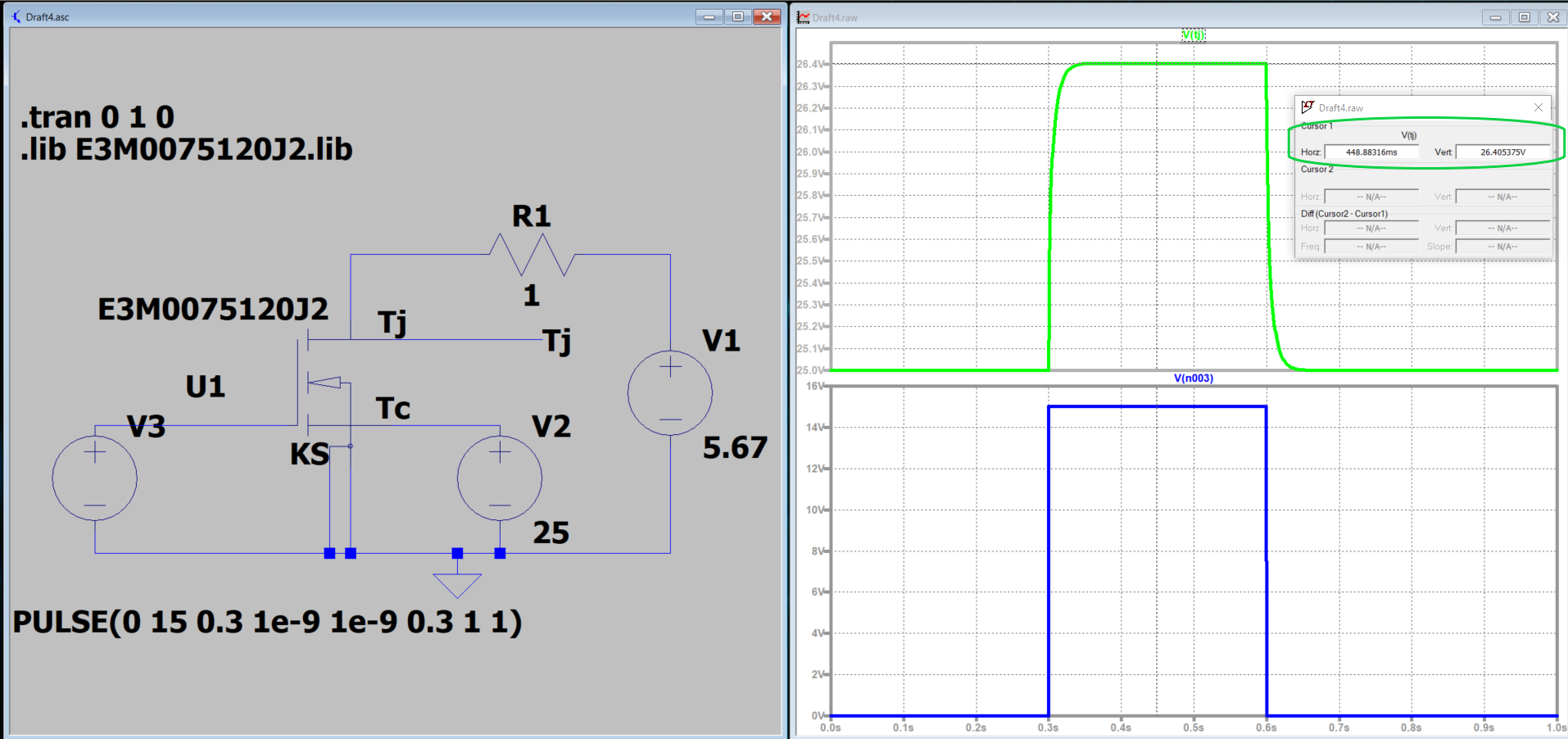LTspice E3M0075120J2 Temperature Rise Simulation

Hello Wolfspeed Team,
I'm working on a reference design and would like to promote your SiC MOSFET.
I'm trying to find the junction temperature rise from passing 5.67-A for 300-ms through E3M0075120J2 drain-to-source to make sure it stays below abs max. I know for a continuous DC temperature rise, I can use this equation, but seems unrealistic for 300-ms ON time.
I tried to simulate in LTspice and see 14°C rise for 300-ms, wanted to double check if I am simulating this correctly. I'm not confident because I tried to do a 60 second simulation and see 4000°C rise when it should not be greater than 199°C. Please take a look and would also like to know how the math works for calculating a transient Trise, I'll need to explain this in the reference design.
300 ms Trise Sim
60 sec Trise Sim
Best regards,
Tilden Chen
Solid State Relays | Applications Engineer

Comments
-
Thank you for your post, it has been approved and we will respond as soon as possible.
0 -
Hello,
Thank you for reaching out and for your interest in promoting our Sic MOSFET in your reference design.
To address your concerns about the junction temperature rise during the 300ms and 60s pulse through the E3M0075120J2
- Transient Temperature Rise calculation
for E3M0075120J2 (Using datasheet)
Thermal resistance from Junction to case = 0.67 C/W
Rdson = 0.07 Ohms at 25C and 5.67A drain-Source current (Using figure 5 of datasheet)Conduction loss = 0.07*(5.67)^2=2.250423W
Delta Temp. = Power*Rth = 2.250423*0.67=1.5077Cfor Rdson = 0.1 Ohms
Conduction loss = 0.1*(5.67)^2=3.214W
Delta Temp. = Power*Rth =2.411*0.67=2.154C- Simulation in LTspice
a) For accurate simulations, one of the thermal terminals must be connected to either a voltage source or a heatsink. For this simulation as all the calculations were taken at 25C, 25V source was connected to Tc node.
b) As can be seen from the simulation (attached) for 300ms, the Tj node voltage (Junction temperature) is 26.405375C i.e. the temperature difference (Tj-Tc) = (26.405375-25) = 1.405375C which is almost equal to the calculated value (1.5077C, error=6.8%)Please feel free to reach out if you need further assistance.
Regards
0 -
Hello Mhusain,
Thanks for your update. My understanding of θJC is that it is the spec is measured with a large heatsink (cold plate) like what is shown below. My board only has copper for the necessary connections, no heatsink, so I am not sure I can use the θJC provided in the datasheet to estimate the thermal rise.
Best regards,
Tilden ChenSolid State Relays | Applications Engineer
0 -
It's also unclear to me how the equations account for time under stress. For example, if I pass 5.67-A for 1e-6 sec vs. 1e6 sec, surely the temperature rise is different. Yet the equations would yield the same result since they do not account for time.
0 -
Hello,
The model only includes junction to case thermal network. To model the external case to ambient Rth (62 C/W), a resistance of the same value must be connected between the Tc terminal and the ambient temperature voltage source (here 25 V). Due to external thermal impedance, the thermal time constant increases significantly (to more than 3s) so the junction temperature will not reach the steady state in 300ms. Also, the model is optimized to work in the temperature range of -55C to 175C, so for the junction temperature to not exceed 175C in this example, Idc = 4.314A was used and the system will require more than 15s (5* time constants) to reach the steady state.
Therefore for 60s pulse it will reach steady state and the calculations for it are as follows:
Rdson = 0.13 Ohm (Figure 5 of datasheet)
power loss = 0.13*4.314^2=2.419W
Rth~62 C/W
Delta Temp. = 62*2.419 = 150CFrom the simulation (attached below), Tj = 174.46V therefore the delta temp. = (174.46-25) = 149.46C which is almost equal to the calculated value (150C).
Let us know if you need further assistance.Regards
 1
1 -
Hello Mhusain,
Thanks for your reply. Did not realize I could simulate the theta JA using R2 in your schematic. Thanks for the explanation!
Best regards,
Tilden ChenSolid State Relays | Applications Engineer
0








